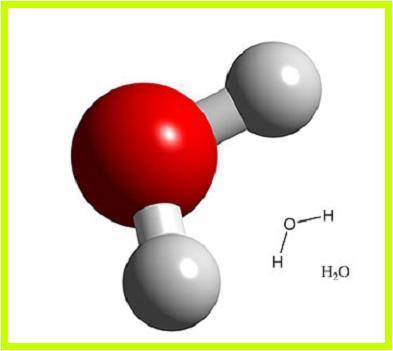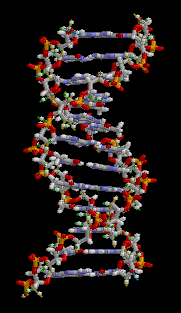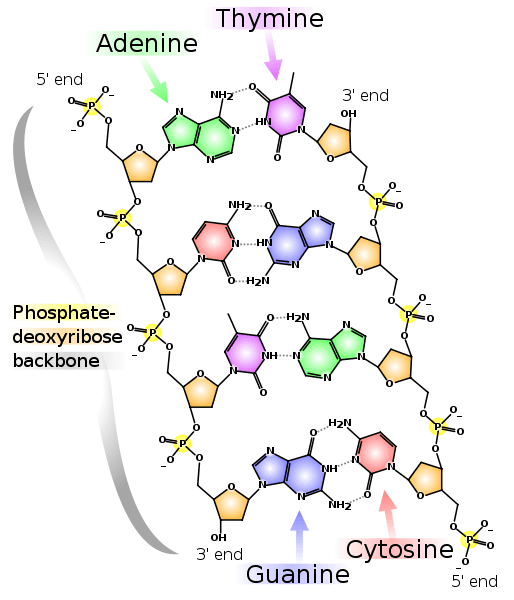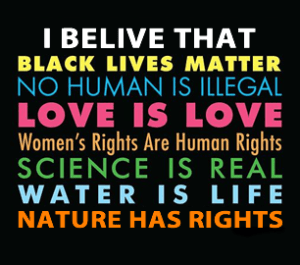Genetic Codes, Cyborg Selves and the Future
“Human beings, like any other component or subsystem, must be localized in a system of architecture whose basic modes of operation are probabilistic, statistical. No objects, space, or bodies are sacred in themselves; any component can be interfaced with any other if the proper standard, the proper code, can be constructed for processing signals in a common translation language.” – (Donna Haraway, A Cyborg Manifesto)
DNA in 2 Paragraphs

Water molecule
As you may have learned, much of human life as we know it through modern molecular biology and genetics is connected to our understanding of DNA (Deoxyribonucleic Acid), the famous double helix. DNA is basically a long polymer of repeating units called nucleotides. Imagine a polymer as a sort a tiny pile of yarn forming a miniature molecule with a specific internal structure. Remember that a molecule is basically two or more atoms forming a chemical bond–H2O=water. That’s an easy example of a molecule! We could think about a lot more complicated ones that water, but that should at least give you a sense of what we are talking about.

DNA double helix
So DNA forms when two molecules grab each other, twist around like a country square dance, and ultimately form into that famous double helix. That DNA molecule includes the four main nucleobases (groups of nitrogen rich molecules): adenine (A), cytosine (C), guanine (G) and thymine (T)–collectively the ACGT nucleotide. (click here for a fun animation explaining all this more) Ok, so molecules are all over the place, doing different things, in different combinations. These four nucleobases (ACGT) attach to sugars in our body and with some other help, eventually form a nucleotide. In case you forgot, or never learned, nucleotides are molecules that hook up and make up RNA and DNA.
This is all extremely simplified, and only gives you a vague sense of what is actually going on in this process. But it should be enough to reinforce the idea of the importance of the DNA and RNA in our bodies, and more importantly for our interests here, DNA serves as the genetic source code of life. As an example, thanks to the Human Genome Project we know that the human genome has just over three billion DNA base pairs and around 23,ooo protein creating genes (and around 75,000 genes total). In comparison, the dog has about 2.4 billion base pairs and around 19,300 protein creating genes, according to research on decoding dog genetics.
One of the things we are also interested in has to do with the question of vision. What does all of this look like, both physically in terms of the cellular activity, but also scientifically. In other words, how does science allow us to “see” genes and the genetic code? What does all of this genetics stuff really look like? The video below shows a computer visualization of how we understand this process at the molecular level, such as moving from DNA to RNA to proteins, and gives us a little insight into how things like DNA coiling, replication, transcription and translation works on a design level. Could you imagine yourself as a genetic designer, trying to come up with something like this as a design? What skills are required to create and render an animation like this? Another questions of vision, and the re-interpretation of science visually.
Molecular Visualization of DNA
Ok, that gives us a little peak into the inner genetic workings of our DNA, but this is all still pretty abstract. Not to fear! We can turn to Bill Nye the Science Guy! (champion of childhood love of science) to help us unravel this genetic mystery. Here’s a little bit more info from Bill about what exactly genetics is all about. For more on DNA and chromosomes from Bill, check this out.
Bill Nye on Genetics
And speaking of genetics and genes, who doesn’t love a good genetics rap, right? Well, we’re in luck, cause Mrs. Harveylicious is ready to stand and deliver! C300 represent. This is what they mean by keeping science education real.
Mrs Harveylicious ~ Genetics Rap
Ok, so that’s all pretty cool. From Steve Nye to Mrs Harveylicious, the science of genetics has a lot going on. To think that this DNA creation process is happening all the time all over our body is pretty awesome. Talk about organic machines! If only Norbert Weiner could see this.
Ok, but that’s still just computer animations about DNA and RNA and proteins. Why should we even care about this at all? What is the importance of understanding this genetic information for science or medicine or politics? How does it tie back in to questions of information encoding and vision? In addition, how might this relate to what Donna Haraway discusses in Cyborg Manifesto about information and biological sciences:
“Communications technologies and biotechnologies are the crucial tools recrafting our bodies. These tools embody and enforce new social relations for women world-wide. Technologies and scientific discourses can be partially understood as formalizations, i.e., as frozen moments, of the fluid social interactions constituting them, but they should also be viewed as instruments for enforcing meanings. The boundary is permeable between tool and myth, instrument and concept, historical systems of social relations and historical anatomies of possible bodies, including objects of knowledge… Furthermore, communications sciences and modern biologies are constructed by a common move – the translation of the world into a problem of coding, a search for a common language in which all resistance to instrumental control disappears and all heterogeneity can be submitted to disassembly, reassembly, investment, and exchange.”
Disassembly, reassembly and exchange is precisely what DNA and RNA in genetics are all about. It’s worth reflecting on that more carefully. In order to get a sense of how these technologies are actually being applied in practice–in a sense to look for the “enforcing of meaning” as Haraway might say (Haraway would also ask us here to remember Rosalind Franklin and the hidden gendered history of the discovery of x-ray chromosomes and eventual DNA models of Crick and Watson).
So let’s hear a little about some recent work on regenerative medicine and think about how genetic information is discussed there and how our understanding of the body creates, translates and shares information in such a way that it allows scientific-medical interventions into genetics to be possible in the first place.
Alan Russell on Regenerative Medicine (TED Talk)
As Alan suggests, this is not sci-fi or Star Trek science, but right here, right now medicine–or at least now as of 2006. So imagine this has seen 6 years of advances since his talk above. But what about areas beyond medicine or genetics. How is our understanding of how nature works and encodes information–whether it is genes or movement or anything else–taken into other areas? One way to think about this is in terms of designs inspired by nature, and the idea of biomimicry. Or cloning. Or genetic engineering. All of these are examples we could think about of how this new sense of life as code or information is shaping our future. Here’s one more example drawing more from the world of design, and with some strong links to both Haraway’s interests in cyborgs as well as other discussions about cybernetics and computer information systems.
Robert Fuller ~ Engineering and Evolution (TED Talk)
For those of you hard-core science geeks, check out Craig Venter’s TED talk about synthetic life and the latest work on synthesizing life in the laboratory. How genetic DNA software can change the physical structural hardware of a cell. Imaging designing a new species of life on your computer, then printing out and encoding the information in DNA. Viola, instant new synthetic thing! Pretty wild stuff!
One final thing to consider, a la the cyborgs. Where does this same technology, when not applied to making new genes or robot insects, end up? One other answer is the robot-human interface–the blending of organic and synthetic technologies, and the digitization of life itself. For a sense of this, we look at the series, Beyond Humans, to see what they have in mind in this brave new world.
The Invasion of the Inhuman
Another idea along these same lines is the “Singularity”– a technofuturist dream that speaks to part of Haraway’s two-pronged vision of technological integration. Here’s a few clips from leading figures in the movement advocating for a new world of designer organisms and controlled evolution.
The Singularity
Until next time…geeks rule!
###



